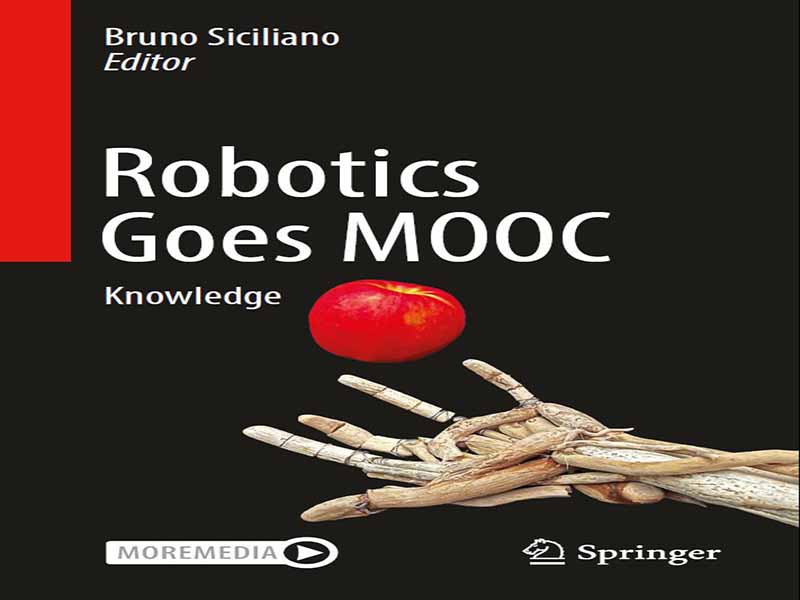- عنوان کتاب: Robotics Goes MOOC
- نویسنده: Siciliano B
- حوزه: رباتیک
- سال انتشار: 2025
- تعداد صفحه: 517
- زبان اصلی: انگلیسی
- نوع فایل: pdf
- حجم فایل: 14.0 مگابایت
تکنیک، جوهره انسان است. با تکنیک، انسانها میتوانند آنچه را که زمانی از خدایان میخواستند، برای خود به دست آورند. تلاشی برای غلبه بر محدودیتهای خود که در آرزوی خلق مصنوعاتی به تصویر و شباهت خود تجلی مییابد: اینگونه بود که ماشین خودکار متولد شد، ماشینی که به خودی خود حرکت میکرد. در طول قرنها، اختراعات مکانیکی از انواع مختلف وجود داشته است: فوارههای خودران، ساعتهایی که با نیروی آب، گرما یا مکانیسم خاصی حرکت میکردند و از انسانها تا موجودات جانورسان یا انساننمای اخیر تقلید میکردند. آنها تاریخ طولانی را از قرون وسطی مسیحی و عربی تا رنسانس ایتالیا، با طرحهای مبتکرانه لئوناردو داوینچی، تا شکوفایی خلاقیتهایی مانند خانواده اندرویدهای ژاکه-دروز و عروسکهای مکانیکی کاراکوری-نینگیو در قرن هجدهم در اروپا و آسیا رقم زدند. بُعد بازیگوشانه اولین ماشینهای خودکار ریشه در دانش فنی پیشرفته آن زمان داشت. در دوره صنعتی، با رواج مفهوم سودمندی ماشین بر هر عملکرد دیگری، شگفتیهای این ماشینهای خودکار را باید به عنوان والدین رباتهای مدرن در نظر گرفت. اصطلاح ربات، با ریشه اسلاو و مترادف کار تابع، از صفحات نویسنده چک، کارل کاپک، در نمایشنامه رباتهای جهانی راسوم (R.U.R.) از سال ۱۹۲۰ گرفته شده است تا به ماشینی انساننما اشاره کند که با مواد آلی طراحی و ساخته شده است تا خستگی انسانها را تسکین دهد. بیست سال بعد، در سال ۱۹۴۰، تصویر ربات با نویسنده روسی، ایزاک آسیموف، به یک مصنوع مکانیکی تبدیل شد، اما در سطح علمی تخیلی. به موازات توسعه رباتیک به عنوان یک علم جدید، شاهد همزیستی اسطورهها و افسانهها با انساننمایی ماشینها بودیم که اغلب با آنچه فناوریهای رباتیک واقعاً هستند، تداخل دارد. برای درک معنای فنی اصطلاح ربات، میتوانیم به تعریف رباتیک در دهه ۱۹۸۰ به عنوان علمی که ارتباط هوشمندانه بین ادراک و عمل را مطالعه میکند، مراجعه کنیم. این عمل توسط یک سیستم مکانیکی مجهز به دستگاه حرکتی برای حرکت (چرخها، ریلها، اندامها، خزندهها) و یک دستگاه دستکاری برای عمل بر روی اشیاء در محیط اطراف (بازوهای مکانیکی، دستهای مصنوعی، دستگاههای انتهایی، ابزارها) ارائه میشود. ادراک به یک سیستم حسی که قادر به کسب اطلاعات در مورد سیستم مکانیکی و محیط است (سنسورهای موقعیت و سرعت، دوربینها، حسگرهای فاصله و مجاورت، حسگرهای نیرو و لمسی) واگذار شده است. اتصال هوشمند به یک سیستم کنترلی واگذار شده است که حرکت را در رابطه با آنچه در محیط اتفاق میافتد، طبق همان اصل بازخورد که عملکردهای بدن انسان را تنظیم میکند، کنترل میکند. بنابراین درک میشود که چگونه رباتها نمیتوانند واقعیت فیزیکی را نادیده بگیرند – نه تنها ذهن و حسگرها مانند هوش مصنوعی (AI)، بلکه بدنهای مکانیکی نیز. در دهه 1990، تحقیقات به دلیل نیاز به استفاده از رباتها برای رسیدگی به مشکل ایمنی انسان در محیطهای خطرناک، افزایش مهارتهای اپراتورها و کاهش خستگی آنها یا تمایل به توسعه محصولاتی برای بازارهای بالقوه بزرگ و طراحی شده برای بهبود کیفیت زندگی، برانگیخته شد. وجه مشترک این سناریوهای کاربردی، چالش فعالیت در زمینههای ضعیف ساختاریافته است که ویژگیهای هندسی یا فیزیکی آنها از قبل کاملاً شناخته نشده و نیازمند مهارت بیشتر و سطح بالاتری از استقلال هستند. در آغاز هزاره جدید، رباتیک طیف گستردهای از کاربردها را شامل رشتههای علمی مختلف مانند بیومکانیک، ادراک لمسی، علوم اعصاب، شبیهسازی مجازی، انیمیشن، یادگیری ماشین و شبکههای حسگر رونمایی کرد. در چشمانداز، توسعه بیشتر آن میتواند با مضامین و دیدگاههایی بر اساس چهار پارادایم کاهش یابد: دانش، طراحی، تعامل و تأثیر. پروژه MOOC رباتیک به چهار جلد تقسیم شده است که هر کدام به یکی از چهار پارادایم فوق اختصاص دارد. محتوا با روشن کردن نکات مشترک در مورد مزایای توسل به سیستمهای رباتیک و پتانسیل ذاتی نوآوری آنها، فراتر از آن چیزی است که در یک کتاب درسی استاندارد در رباتیک یافت میشود. از سوی دیگر، مباحث با سطحی سبکتر از تعمیق چالشهای تحقیقاتی، مانند آنچه در کتابچه راهنمای رباتیک اشپرینگر که به طور گسترده شناخته شده است، مطرح شدهاند، با هدف روشنِ دسترسی به کاربران جدید و جوامع جدید علم و فناوری رباتیک در کاربردهای متفاوت، ارائه شدهاند. در عوض، چالشهای حوزههای نوظهور، منبع فراوانی از تحریک و بینش برای حوزه رباتیک را فراهم میکنند. در واقع، در تقاطع رشتهها است که انتظار میرود چشمگیرترین پیشرفتها اتفاق بیفتد. هشت فصل هر کتاب شامل موارد آزمایشگاهی، کاربردها و مثالهای مفید است. نوآوری اصلی این پروژه نسبت به متون قبلی، دوره آموزشی آنلاین و رایگان مرتبط با عنوان «رباتیک و رباتها» است که در sn.pub/NNHqHS موجود است. این دوره منحصر به فرد
Technique is the essence of the human being. With the technique, human beings can obtain for themselves what they once asked of the Gods. A push to overcome one’s own limits that is projected into the ambition to create artifacts in one’s own image and likeness: this is how the automaton was born, a machine that moved by itself. Through the course of centuries, there were mechanical inventions of various types: self-propelled fountains, clocks which moved by the force of water, heat, or a particular mechanism, emulating human beings up to the recent zoomorphic or anthropomorphic creatures. They marked a long history from the Christian and Arab Middle Ages to the Italian Renaissance, with the ingenious designs of Leonardo da Vinci, up to the flourishing in Europe and Asia of creations such as the Jaquet- Droz family of androids and the karakuri-ningyo mechanical dolls of the eighteenth century. The playful dimension of the first automatons was rooted in the frontier technical knowledge of the time. In the industrial period, with the prevalence of the concept of machine utility over any other function, the wonders of these automata are to be considered as the parents of modern robots. The term robot, of Slav origin and synonym of subordinate work, comes from the pages of the Czech writer Karel ˇCapek in the drama Rossum’s Universal Robots (R.U.R.) from 1920 to indicate an anthropomorphic machine designed and built with organic material to relieve the fatigue of humans. Twenty years later, in 1940, the image of the robot changed becoming a mechanical artifact with the Russian writer Isaac Asimov, yet at the level of science fiction. In parallel to the development of robotics as a new science, we observed the coexistence of myths and legends with the anthropomorphization of machines which often interferes with what robotic technologies really are. To get to understand the technical meaning of the term robot, we can refer to the definition of robotics of the 1980s as the science that studies the intelligent connection between perception and action. The action is offered by a mechanical system equipped with a locomotion apparatus to move (wheels, tracks, limbs, crawlers) and a manipulation apparatus to act on the objects in the surrounding environment (mechanical arms, artificial hands, end-effectors, tools). Perception is entrusted to a sensory system capable of acquiring information on the mechanical system and on the environment (position and speed sensors, cameras, distance and proximity sensors, force and tactile sensors). The intelligent connection is entrusted to a control system that governs motion in relation to what happens in the environment, according to the same principle of feedback that regulates the functions of the human body. It is therefore understood how robots cannot ignore physical reality—not only minds and sensors as in artificial Intelligence (AI), but also mechanical bodies. In the 1990s, research was stimulated by the need to use robots to address the problem of human safety in hazardous environments, to increase the skills of operators, and to reduce their fatigue or by the desire to develop products for potentially large markets and designed to improve the quality of life. A common denominator of these application scenarios is the challenge of operating in poorly structured contexts, whose geometric or physical characteristics not completely known a priori require increased skills and a higher level of autonomy. At the turn of the new millennium, robotics unveiled a wide spectrum of applications involving different scientific disciplines such as biomechanics, haptic perception, neuroscience, virtual simulation, animation, machine learning, and sensor networks. In perspective, its further development can be declined by themes and visions on the basis of four paradigms: knowledge, design, interaction, and impact. The Robotics Goes MOOC project is organized into four volumes, each devoted to one of the above four paradigms. The contents go beyond those to be found in a standard textbook in robotics by enlightening the common threads on the advantages of resorting to robotic systems and their inherent potential of innovation. On the other hand, the topics are dealt with a lighter level of deepening on the research challenges, such as in the widely known Springer Handbook of Robotics, with the clear intent of an outreach toward new users and new communities of robotics science and technology in disparate applications. In return, the challenges of the new emerging areas are proving an abundant source of stimulation and insights for the field of robotics. It is indeed at the intersection of disciplines that the most striking advances are expected to happen. The eight chapters of each book contain useful lab cases, applications, and examples. The main novelty of the project over the previous literature is the associated MOOC course “Robotics & Robots” available at sn.pub/NNHqHS. This unique complement features video lectures by some of the chapters’ authors and supporting slides containing exercises, schemes, and tables summarizing the most important concepts explained in the online videos, with the goal of facilitating the comprehension of the various concepts.
این کتاب را میتوانید بصورت رایگان از لینک زیر دانلود نمایید.
Download: Robotics Goes MOOC



































نظرات کاربران